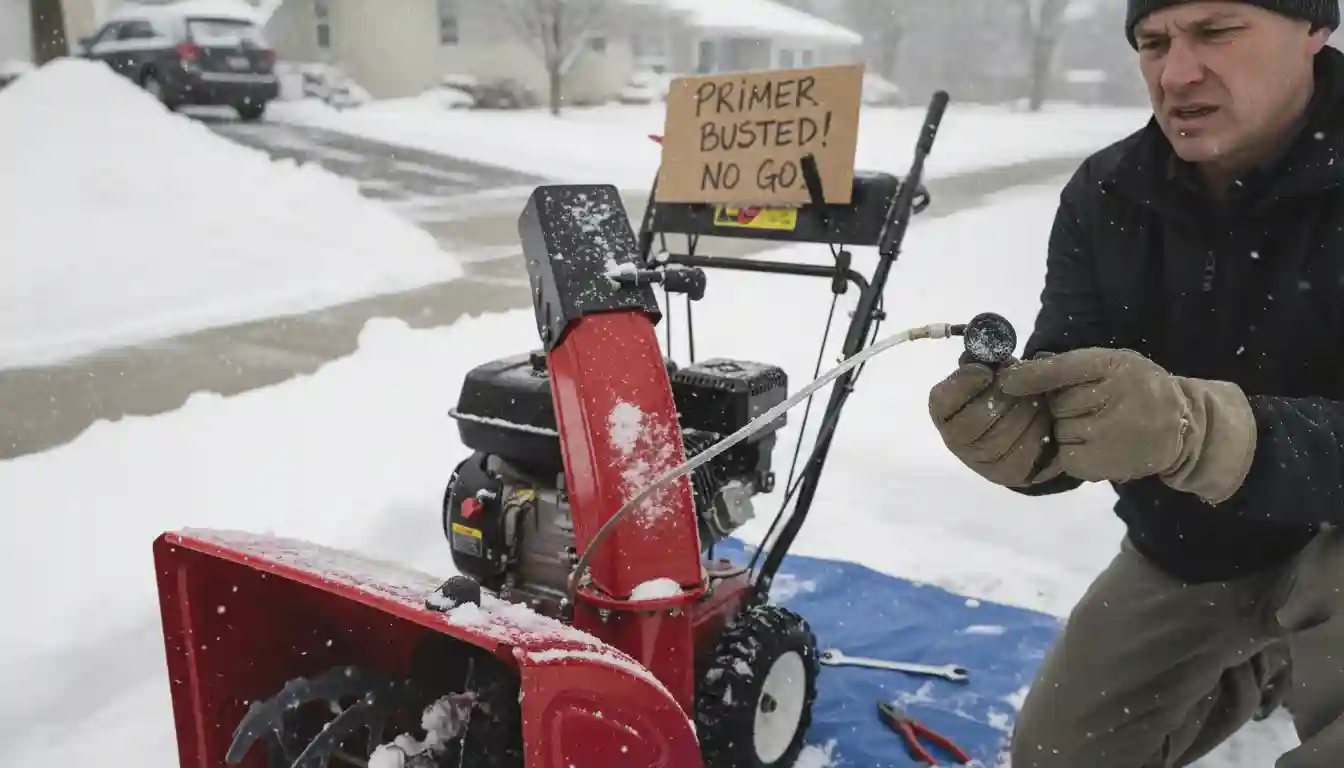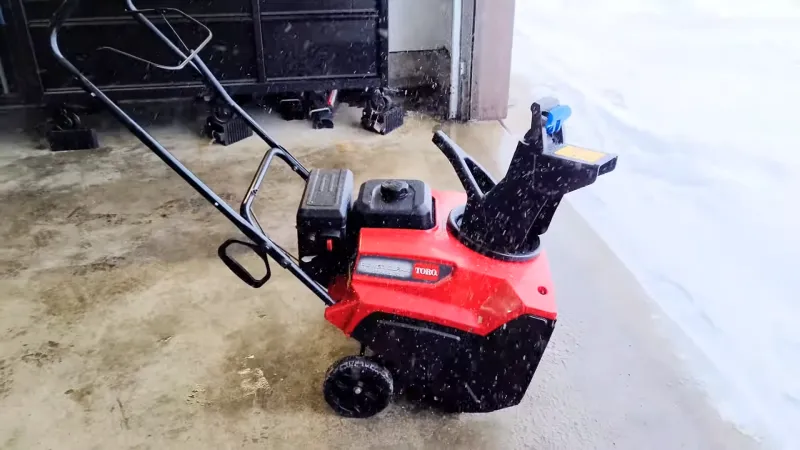Primer Not Working on Snowblower? Learn How to Diagnose and Fix the Issue with Our Guide
If you own a snowblower, you’re likely aware of the importance of a primer. Primers help to create a combustible mixture of fuel and air that can get your engine started, especially in colder temperatures.
However, if your primer isn’t working properly, it can be frustrating and make it difficult to start your snowblower. In this blog post, we’ll explore why a primer might not be working on your snowblower and what you can do to fix the issue.
It’s important to address this problem as quickly as possible, as a malfunctioning primer can prevent your snowblower from starting altogether, leaving you stranded in the cold.
You'll Learn About
Causes of a Primer Not Working
The primer bulb is an essential component of a snowblower’s fuel system that helps draw fuel into the engine for starting. When the primer bulb fails to work, it can make starting the snowblower a difficult or even impossible task. Several factors could cause a primer not to work as intended, and it’s crucial to understand these causes to troubleshoot and fix the issue.

Cracked or Damaged Bulb
One common cause of a primer not working is a cracked or damaged bulb. Over time, the rubber or plastic bulb can develop cracks or holes, which allow air to enter the fuel system and prevent fuel from flowing correctly.
A damaged bulb may also fail to create the necessary pressure to draw fuel into the carburetor. To diagnose this issue, inspect the primer bulb for any visible cracks or tears, and replace it if necessary.
Blockages
Blockages in the fuel system can also cause a primer not to work. Dirt, debris, or old fuel can clog the fuel lines, fuel filter, or carburetor, preventing fuel from reaching the engine. To diagnose this issue, disconnect the fuel lines and inspect them for any blockages.
If you find blockages, remove them using a cleaning solution or a small wire brush.
Different Component Malfunctions
Malfunctions in the valves, gas lines, fuel filter, or carburetor can also cause a primer not to work. For instance, a clogged fuel filter can prevent fuel from flowing through the system, while a malfunctioning carburetor can prevent fuel from mixing with air correctly. To diagnose these issues, check each component for visible damage or signs of wear and tear, and clean or replace them if necessary.

A primer not working on a snowblower can be frustrating, but it’s essential to identify the underlying causes and fix them to ensure your snowblower starts correctly. Regular maintenance and inspection of the fuel system components can prevent many issues from arising and keep your snowblower in top condition. If you’re unsure about any aspect of troubleshooting or repair, seek assistance from a qualified professional.
Diagnosing the Problem
If your primer is not working on your snowblower, it’s essential to diagnose the issue before attempting to fix it. Here’s how you can diagnose the issue:
Disconnect the Priming Line From the Carburetor
First, locate the priming bulb and the priming line connected to the carburetor. Then, disconnect the priming line from the carburetor.
Hold It Near Your Ear
Hold the priming line close to your ear while you push the primer bulb a few times. Listen for any sound of air escaping.
Determine the Issue
If you hear air escaping, it means that the priming bulb is working correctly, and the issue may lie elsewhere in the fuel system. However, if you don’t hear any air escaping, it could mean that there’s a hole in the priming line or bulb.
What to Do if No Air Comes Through?
If you don’t hear any air coming out of the priming line, it’s essential to check for any damage. Here’s what you can do:
Check the Priming Line for Damage
Carefully inspect the priming line for any signs of cracks, holes, or wear and tear. If you find any damage, replace the line with a new one.
Check the Priming Bulb for Damage
Inspect the priming bulb for any damage, such as cracks or holes. If you find any damage, replace the bulb with a new one.
Clean the Carburetor
If the priming line and bulb appear to be in good condition, the issue may lie in the carburetor. The carburetor may be clogged with debris or dirt, preventing the primer from working correctly. To fix this, clean the carburetor using a carburetor cleaner or take it to a professional for cleaning.
Replace the Fuel Filter
If the carburetor is not the issue, the fuel filter may be clogged, preventing fuel from reaching the carburetor. Replace the fuel filter with a new one to fix the issue.
if your snowblower’s primer is not working correctly, it’s important to diagnose the issue before attempting to fix it. By following the above steps, you can determine the cause of the problem and fix it accordingly.
Fixing the Problem
Fixing the problem of a primer not working on a snowblower can involve various steps depending on the root cause of the issue. Here are some common solutions to consider:
Replacing the Priming Bulb
If the bulb is cracked or damaged, it needs to be replaced. Start by removing the old bulb and checking for any cracks or holes. Then, purchase a replacement bulb that matches the make and model of your snowblower.
Insert the new bulb into the housing and connect the fuel lines.
Clearing Blockages in the Fuel System
If there are blockages in the fuel system, the primer will not work effectively. Start by removing the fuel cap and checking for any debris or blockages in the fuel tank. Use a fuel filter to remove any debris or sediment from the fuel.
You may also need to remove the carburetor and clean it thoroughly using carburetor cleaner.
Replacing the Valves, Gas Lines, or Fuel Filter
If there is a malfunction in any of these parts, they need to be replaced. Start by identifying which part is causing the issue. You can test the fuel filter by blowing through it; if no air passes through, it needs to be replaced.
If you suspect that the valves or gas lines are causing the problem, it may be best to take your snowblower to a professional for repair.
Adjusting the Carburetor
If the carburetor is not adjusted properly, the primer may not work correctly. Start by locating the adjustment screws on the carburetor and turning them according to the manufacturer’s instructions. You may also need to clean the carburetor to ensure that it is functioning correctly.
Replacing the Priming Line
If there is a hole or crack in the priming line, it will need to be replaced. Start by removing the old line and checking for any damage. Purchase a new priming line that matches the make and model of your snowblower and connect it to the priming bulb and carburetor.
Overall, fixing the problem of a primer not working on a snowblower can be a simple or complex task depending on the root cause of the issue. By following the steps outlined above, you can diagnose and fix the problem, ensuring that your snowblower is in good working order.
Preventing Future Issues
Preventing future primer issues is essential to ensure the longevity and optimal performance of your snowblower. Here are some tips to keep in mind:
Regular Maintenance
Regular maintenance is key to preventing primer issues. This includes regular oil changes, cleaning or replacing the air filter, and checking the spark plug. Refer to your snowblower’s manual for specific maintenance instructions.
Proper Storage
Properly storing your snowblower during off-seasons is important for preventing primer issues. Drain any remaining fuel from the tank and run the snowblower until it stops to prevent the fuel from gumming up the carburetor. Store the snowblower in a dry, covered area to protect it from moisture and debris.
Use High-quality Fuel
Always use high-quality fuel in your snowblower. Fuel that is contaminated or contains too much ethanol can damage the carburetor and fuel system, leading to primer issues.
Keep the Fuel System Clean
Dirt, debris, and old fuel can clog the fuel system and prevent the primer from working properly. Use a fuel stabilizer and fuel system cleaner to prevent these issues.
Replace Worn Parts
Worn or damaged parts, such as the primer bulb or fuel lines, can cause primer issues. Regularly check these parts and replace them if necessary.
By following these tips, you can prevent future primer issues and ensure your snowblower runs smoothly all winter long.
Final Words
The primer bulb is not drawing fuel into the carburetor despite confirming that there is fuel in the bowl and the fuel line is not blocked. It is also mentioned that the carburetor has been cleaned twice and is in good condition.
One possibility could be that the primer bulb or its hose is damaged, causing it to suck in air instead of fuel. Another possibility could be that there is a problem with the valves, gas lines, fuel filter, or carburetor that is preventing the primer bulb from working properly.
It is recommended to check the primer bulb and its hose for any damage and to also inspect the valves, gas lines, fuel filter, and carburetor for any issues. Additionally, it may be worth checking if the float is set correctly and if the idle/main needle screws are seated properly.
